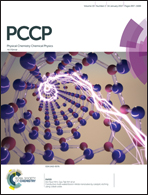Effect of doping and chemical ordering on the optoelectronic properties of complex oxides: Fe2O3–V2O3 solid solutions and hetero-structures
Abstract
The electronic and optical properties of α-(Fe1−xVx)2O3 at low (x = 0.04) and high (x = 0.5) doping levels are investigated using a combination of periodic and embedded cluster approaches, and time-dependent density functional theory. At low V concentrations the onset of the optical absorption is ∼0.5 eV (i.e., nearly 1.6 eV lower than that in pure α-Fe2O3) and corresponds to the electron transitions from V 3d to Fe 3d* orbitals. At high V concentrations, optical absorption energies and intensities are sensitive to specific arrangements of Fe and V atoms and their spin configuration that determine Fe–V hybridization. The onset of the lowest inter-vanadium absorption band in the case of Fe2O3/V2O3 hetero-structures is as low as ∼0.3 eV and the corresponding peak is at ∼0.7 eV. In contrast, in the case of solid solutions this peak has lower intensity and is shifted to higher energy (∼1.2 eV). Analysis of the orbital character of electronic excitation suggests that Fe2O3/V2O3 hetero-structures absorb light much more effectively than random alloys, thus promoting efficient photo-induced carrier generation. These predictions can be tested in α-(Fe1−xVx)2O3 thin films synthesized with well-controlled spatial distribution of Fe and V species.



 Please wait while we load your content...
Please wait while we load your content...